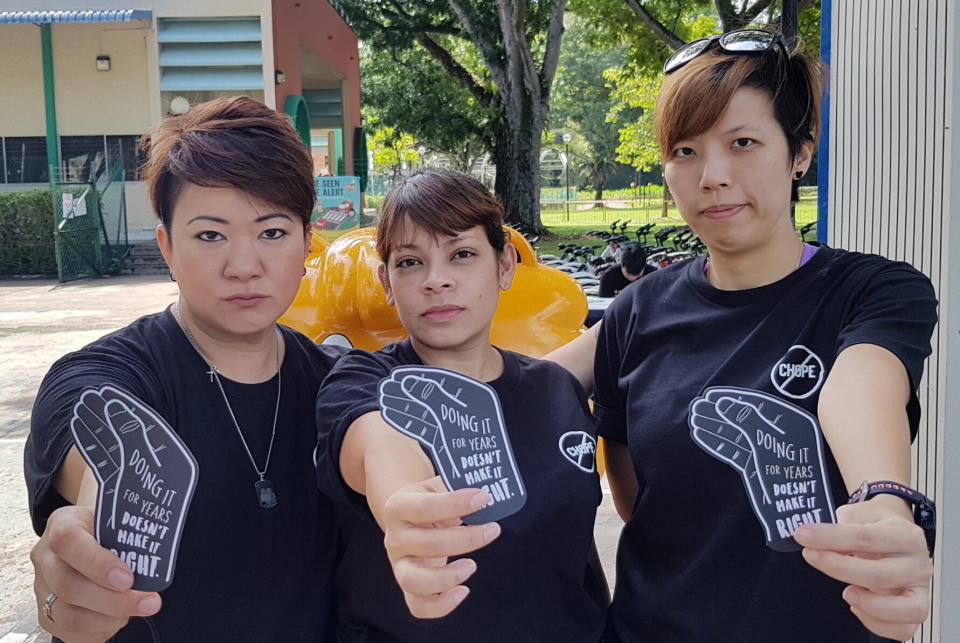Woman targets Singaporeans who 'chope' at eating places by placing message cards

SINGAPORE — Katelin Teo, 43, had sat down for lunch in a food centre, not knowing that the table had been “choped” (Singlish for reserving) by a person with a half-filled water bottle.
When the stranger arrived back and asked her to leave the seat, Teo stood firm and refused to move. Angered, the man flashed his middle finger and eventually walked away.
“To me, it’s my right to sit down at the table,” said Teo, associate general secretary of partnerships at the Singapore Kindness Movement (SKM).
The incident, along with her observations of such “ungracious” behaviour by fellow Singaporeans in public eating places, spurred Teo to start a small movement that aims to tackle her “long-drawn pet peeve”.
“‘Chope-ing’ is done everywhere and anywhere - hawker centres, food court in malls and even fast food centres like McDonald’s and Jollibee,” said Teo, who was formerly working in the advertising industry. “Singaporeans eat round the clock - and ‘chope-ing’ happens round the clock.”
“Just because it has been done for years doesn’t make it right,” she added.
The Anti-Chope Movement, which was started by Teo in April last year, attempts to correct such social behaviour.
Each time she sees a table or seat “choped” with an item, such as a packet of tissue paper or an umbrella, she leaves a specially-designed card on top of it that reminds patrons not to do it.
Around 500 cards have been given out by Teo over a six-month period during her twice-a-week visits to food courts and hawker centres. Her friends, Stacey Ann Nonis, 38, and Julia Hee, 34 - both from the finance sector - have joined Teo in her mission.
For her efforts, the Anti-Chope Movement was among 22 ground-up movements and individuals - including actors Adrian Pang, Li Nanxing and Constance Song - to be inducted into the SKM’s Kindred Spirit Circle last Saturday (25 May).

While her attempts so far have mostly been met with confusion, with some mistaking it for a prank, or indifference (“they frown, look around and put the card aside and continue with their food”), Teo remains undeterred.
For a start, buoyed by recent media coverage, netizens have left positive feedback on the movement’s Facebook page, denouncing the Singaporean habit of “chope-ing”.
“It is good to see that there are like-minded people out there,” said Teo.
More social media awareness would help the cause, especially getting more “ambassadors” on board and stationing them at more notorious “chope-ing” spots, including hawker centres in Chinatown and Raffles City, she added.
While getting people to stop “chope-ing” would be a “long-drawn” effort, Teo remains optimistic that it would take off with enough awareness.
For instance, her movement can take heart from the positive response to the National Tray Return Initiative, launched by the National Environment Agency (NEA) and the SKM in 2012.
With messages to return trays highlighted at many eating places, diners have been spurred into clearing their tables after eating, she explained. Findings from a 2018 survey by the Singapore Management University (SMU) released earlier this month showed that almost five in 10 respondents said they clear their food utensils at hawker centres most or all of the time.
One way to tackle the issue of “chope-ing” is for diners to leave after eating, especially during peak hours, “so people don’t have to be ‘kiasu’ (Singlish for scared to lose) and ‘chope’”, noted Teo.
“I know I would be challenged by people who are time-conscious and think this is the most efficient way to conduct your lunch...(but) I am confident (that Singaporeans will break the habit),” she added.
“It will take years, but if everybody is on board, eventually.”
More Singapore stories:
Almost half of Singapore residents clear their food utensils at hawker centres: survey
From back alley to office, volunteers give free haircuts for those in need


